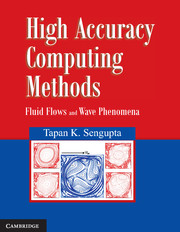Book contents
- Frontmatter
- Contents
- Foreward
- Preface
- Chapter 1 Basic Ideas of Scientific Computing
- Chapter 2 Governing Equations in Fluid Mechanics
- Chapter 3 Classification of Quasi-Linear Partial Differential Equations
- Chapter 4 Waves and Space–Time Dependence in Computing
- Chapter 5 Spatial and Temporal Discretizations of Partial Differential Equations
- Chapter 6 Solution Methods for Parabolic Partial Differential Equations
- Chapter 7 Solution Methods for Elliptic Partial Differential Equations
- Chapter 8 Solution of Hyperbolic PDEs: Signal and Error Propagation
- Chapter 9 Curvilinear Coordinate and Grid Generation
- Chapter 10 Spectral Analysis of Numerical Schemes and Aliasing Error
- Chapter 11 Higher Accuracy Methods
- Chapter 12 Introduction to Finite Volume and Finite Element Methods
- Chapter 13 Solution of Navier–Stokes Equation
- Chapter 14 Recent Developments in Discrete Finite Difference Computing
- Exercises
- References
- Index
Chapter 4 - Waves and Space–Time Dependence in Computing
Published online by Cambridge University Press: 05 January 2014
- Frontmatter
- Contents
- Foreward
- Preface
- Chapter 1 Basic Ideas of Scientific Computing
- Chapter 2 Governing Equations in Fluid Mechanics
- Chapter 3 Classification of Quasi-Linear Partial Differential Equations
- Chapter 4 Waves and Space–Time Dependence in Computing
- Chapter 5 Spatial and Temporal Discretizations of Partial Differential Equations
- Chapter 6 Solution Methods for Parabolic Partial Differential Equations
- Chapter 7 Solution Methods for Elliptic Partial Differential Equations
- Chapter 8 Solution of Hyperbolic PDEs: Signal and Error Propagation
- Chapter 9 Curvilinear Coordinate and Grid Generation
- Chapter 10 Spectral Analysis of Numerical Schemes and Aliasing Error
- Chapter 11 Higher Accuracy Methods
- Chapter 12 Introduction to Finite Volume and Finite Element Methods
- Chapter 13 Solution of Navier–Stokes Equation
- Chapter 14 Recent Developments in Discrete Finite Difference Computing
- Exercises
- References
- Index
Summary
Introduction
Waves are usually associated with hyperbolic partial differential equations. What waves have to do in general with CFD? It is noted earlier that many problems governed by parabolic or elliptic PDEs require numerical algorithms which treat the problems as belonging to hyperbolic system. It is explained later that the numerical characteristics of the equivalent hyperbolic system must include the single characteristic of a parabolic system for the method to be stable and accurate. Similarly, solving an elliptic PDE by iterative methods is equivalent to solving an equivalent time-evolution problem. In fact, it is in this context the eigenvalues and eigenvectors of associated linear algebraic system provide physical justification. Thus, this chapter contains expository material in understanding wave-attributes of many problems which support waves directly as in hyperbolic system or any other system that supports dispersive waves.
Wave motions have the characteristic property that after a signal (information) is observed at one point, a closely related signal (information) may later be observed at a different point. Thus, waves are the means by which information travel in space and time, without significant movement of the medium. Quite often, what is perceived as motion is related to movement of phase and energy. These two motions are characterized by phase speed and group velocity which will be described shortly.
- Type
- Chapter
- Information
- High Accuracy Computing MethodsFluid Flows and Wave Phenomena, pp. 38 - 70Publisher: Cambridge University PressPrint publication year: 2013



